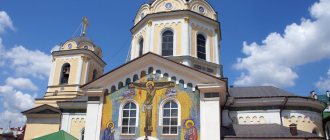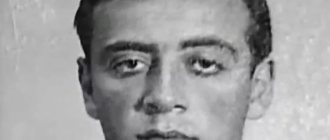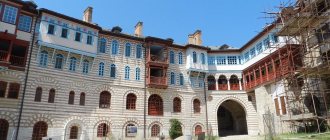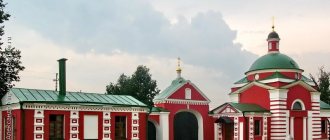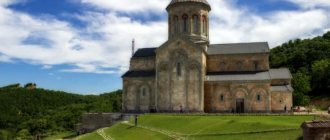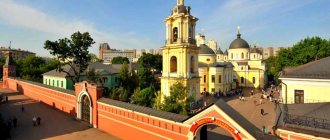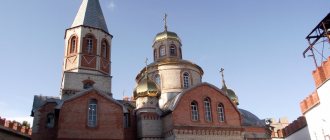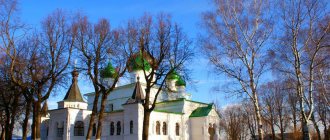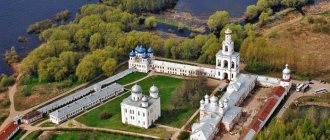The location of this monastery is the historical center of the city. There are quiet old houses and narrow streets, so those who come by car often lament the inconvenience of parking. But time after time, pilgrims return here - to the blessed place where St. Luke of Crimea once served, and now miracles are created through his prayers.
Holy Trinity Cathedral, Simferopol.
Historical reference
Once upon a time, Odesskaya Street, where the monastery is now located, was called Grecheskaya, because it was the area where representatives of this national community lived. It was they who once brought Christianity to the land of Crimea, and later experienced persecution more than once from the Turkish authorities, under whose protectorate the peninsula was until 1783. And already in the 20th century. The Greeks were destined to protect this Trinity Church from closure, which later gave rise to the monastery.
Parish Church
This was precisely the original status of the temple, now the main one for the Trinity Monastery. Upon the annexation of Crimea to the Russian Empire, local Greeks turned to the newly appointed bishop, asking for permission to build a church for the Greeks, with services in the national language. It was assumed that it would be erected “with our own money,” that is, with the money of parishioners. So on May 7, 1796, the Church of the Holy Trinity was founded.
The original history of the temple is directly related to the Simferopol Greeks.
- The greatest contribution to the construction was made by the Greek merchant, Constantine Yani Barako. From his youth, he was in Russian military service for more than 20 years, participated in the Russian-Turkish War of 1768-74, even the famous Battle of Chesma. After receiving his resignation, he opened his own business and did a lot of church charity work. Subsequently, Barako bequeathed a considerable amount of expensive real estate to the temple. The income it brought in was such that it allowed the parish and the entire clergy to exist for the next 100 years, and even maintain a school.
- History has preserved the names of the Greek priests, Nicholas Paximade, as well as his son John, who later replaced his father as rector of the temple. Father John distinguished himself during the Crimean War (1853-56), when he was a military priest. It was under the leadership of Fr. John, construction of a stone building began.
Architecture
27
September
1868
The newly built stone church in honor of the Holy Trinity was consecrated.
The author of the project is Ivan Fedorovich Kolodin, a student of the famous architect A.N. Voronikhin, creator of the Kazan Cathedral in St. Petersburg. It is assumed that the last years of his life I.F. Kolodin lived on the Crimean land, and this is where the temple project appeared.
Its architectural features are reminiscent of Greece: according to the Byzantine tradition, the building was built in the form of the so-called “Greek cross”, the facade is decorated with stucco molding of the so-called “Corinthian order”, implying brightness and elegance.
Useful materials
Persecution
With the beginning of the mass closure of churches by the atheistic authorities, Trinity was robbed several times under the guise of “seizure of church valuables” for the hungry, but they managed to save the parish and continue services. When the main temple of Simferopol was closed in 1930, Trinity was a cathedral for some time. But already in 1933, a decision was made to transfer the building to a boarding school and to stop services. The Greek parishioners of the church, however, did not give up; through Greek diplomats they managed to defend the temple from closure. But his ministers and parishioners did not escape arrest.
Church of St. Luke in the disappeared village of Laki
The road gradually rises to the Laki Pass. Nearby are the ruins of a church. Unfortunately, this is all that remains of the ancient Greek village of Laki - a village of amazing and heroic history.
There was a piece of ancient Hellas in these places. Like an eagle's nest, this village nestles on rocky land near the pass between the Tatar-Yalta and Ai-Ilya mountains.
Past the man-made lake, past the worship cross, the path leads to an ancient temple. Next to it is a small cemetery. At a distance is a tiny monastery. A little lower, in the valley, there are well-preserved pools with duckweed-covered black water. How old are these buildings - one hundred, three hundred, six hundred?... It is believed that the name “Laki” or “Laka” is translated from Greek and means “pool”. There is another version of the origin of this toponym. Researcher A.L. Berthier-Delagarde believed that it comes from the name of St. Luke.
These places have been inhabited since ancient times. In the area of the village of Laki, traces of two small settlements of the 6th-8th centuries were discovered. Until recently, nearby were the remains of the Church of St. Trinity - a small cross-domed church of the 13th - early 14th centuries, shaped like a cube with equal branches of a cross, three apses and four standing octagonal columns, and not far from it are the ruins of an even more ancient temple with the remains of a cemetery. On one of the tombstones there is an inscription dating back to 1362.
The ruins standing by the road belong to the Church of St. Luke, erected in 1904 by village residents on the site of an old wooden church from the 16th century. Above the entrance to the temple is inscribed the date of construction of the church and the words of Christ in modern Greek: “Come, all you who labor and are heavy laden, and I will give you rest.” And on the lower arch there is an inscription: “Church of the Holy Evangelist Luke.”
The Church of St. Luke is a typical cross-domed single-nave structure, oriented with its apse to the east. The dome is built on a light drum, which, through sails and girth arches, rests on four pylons built into the walls, forming an under-dome square in the middle cross. The ornamental painting of the pylons has been lost. The main western entrance to the temple is decorated with a portal.
The altar was completely destroyed, but the frescoes were preserved. In some places the gloomy faces of saints, angels, a lion, an eagle and an ox are clearly visible. The Evangelist Matthew is depicted as an angel, the Evangelist Mark is symbolized as a lion, and the Evangelists Luke and John are symbolized by the image of an eagle and a calf.
Remains of the painting of the Church of St. Luke in the village of Laki. Summer 2010
The holy apostle and evangelist Luke was revered and respected by all Christians, but especially by the Greeks, to whom he, also a Greek by nationality, although a native of Syria, was especially close. However, it is strange that the Lak temple was the only temple in the name of St. Luke in Crimea. The Apostle Paul called St. Luke is a doctor. Besides this, St. Luke knew the art of painting.
The temple stands on a hillock, surrounded by a dense wall of weeds - nettles, sorrel. In front of the entrance there are stone blocks on the ground from the destroyed bell tower dome.
Nowhere in Crimea is there a temple like this. It is unique not only for its architecture. He is individual in his spirit. The presence of dozens of human restless souls is clearly felt here.
Lucky. A village that no longer exists
You won't find it on maps or guidebooks. It is not even on the ground, under the rocks hanging over the gardens. “Unfortunately, those people who remembered the smell of this land, the sight of these mountains at any time of the year, tobacco blossoms, neat houses with front gardens, a small shop where women gossiped and old men smoked pipes, a church, streets, where there were jugs of bekmes - an apple and pear drink. This is for everyone. Anyone come and drink, please!”
But not only bekmes was treated here to each other and guests. Good people lived in Laki: the table was full, and the owners always rejoiced at their guests. Not only the sultry blue sky, the steep, as if specially hewn rocks in the distance, the green slopes of the mountains and the air sparkling with the sun made this land related to Hellas. Freedom-loving, free people lived in it. Many wonderful people grew up on Lak land.
A person who finds himself in the cozy Lak Valley for the first time is amazed by its silence. This silence is somehow special, there is nothing like it anywhere else in Crimea. The sun-scorched chalk mountains stand silently. The trees are not swayed by the wind. You can't hear the buzzing of bees. Only a lone hare will run across a field strewn with huge red poppies. Nature is silent.
Lak Valley
But if you listen more closely to these mountains and trees, look into the scarlet blood of the poppies, they will begin to speak. They will tell a terrible story that has been kept for more than 60 years.
The blood of proud Theodorites flowed in the veins of the local residents. Those true indigenous Crimean people who were respected far beyond the peninsula. It has always had its own little world. The villagers were not particularly interested in the events that took place further than Mount St. Ilya, towering above Laki. People grew excellent tobacco and grapes, raised livestock, and raised children. They didn’t really allow strangers in, although they were always greeted cordially. The entire village was made up of several dynasties that had lived here since time immemorial. The melodious Greek surnames Spai, Leli, Arvanidi come from these places. So the Lak land would have given birth to new hard-working Crimeans if, on one chilly winter morning in 1942, a car with Germans had not stopped at the house of the chairman of the collective farm “Neo Zoi” (“New Life”) Vladimir Lelya. From that moment on, a different life began in Laki.
A tragedy similar to the Belarusian Khatyn also happened in Crimea. By some mystical coincidence, it happened exactly a year before the burning of Khatyn - to the same day - March 23, 1942.
Crimean Khatyn was called Laki
You can’t write, you can’t talk about this village without deep mental pain.
… “Today, March 24 (1942), the scouts reported terrible news: on March 23, the village of Laki was burned and completely destroyed . The Nazi scoundrels and their vile hirelings burned the entire village to the ground, destroyed the club, school, village council building, store, residential buildings of collective farmers and even a church, and shot 16 women, old people and children, including Elena Gavallo with her 8-month-old child . The corpses of those shot were thrown into one of the cellars, doused with gasoline and burned.” These are lines from the book “Flame over the Crimea” by the former commander of the Bakhchisarai detachment, and then the Southern Unit, later a Hero of Socialist Labor, director of the Koktebel state farm, Mikhail Andreevich Makedonsky.
“This is how Laki, a partisan village, Crimean Khatyn, died” (B. Serman. “Mountain Woman.” Newspaper “Crimean Truth”, 09/26/1963).
Another witness to the destruction of the rebellious village was Yuri Mikhailovich Spai, the nephew of Nikolai Konstantinovich Spai, the legendary intelligence officer of the Karasubazar partisan detachment, who carried out special assignments from the central headquarters. Nikolai Spai was betrayed as a traitor and hanged by the Nazis. One of the streets in Belogorsk is named in his honor. Yuri Mikhailovich Spai is already over seventy. Then, in 1942, he was a thirteen-year-old boy.
“When the Nazis defeated the partisan detachment, those who remained alive came to our village. On March 23, 1942, the village was surrounded by Germans and volunteers - Crimean Tatars from the punitive battalion, says Yuri Spai. “All the residents were gathered in front of the Village Council and searched. Apparently, the Germans received a denunciation, because, despite the fact that they did not find anything suspicious, more than thirty men were immediately driven aside. Among them were my uncle and two brothers. I, then still a naive teenager, came up and asked: “Uncle Mitya, why are you here?” And he answered me in Greek, so that the Tatars would not understand: “Yura, leave, otherwise they will kill you too. We are being led to execution." This cannot be forgotten..."
The village was set on fire, dogs barked loudly, and people panicked. All the “dirty” work was done by the Tatars. Aunt Yuri Mikhailovich was tied to the bed, and her eight-month-old child was thrown into the fire like a rag. The woman screamed until the burning roof collapsed on her. The fire destroyed all 87 households. Those who survived, including Yuri Spai, accompanied by Crimean Tatar volunteers, were sent through Bakhchisarai to Oktyabrskoye. The war claimed seventeen lives in the Spai family, Yura’s father died, and his mother joined a partisan detachment.
Why did they burn this particular village? Why were the Nazis so merciless towards its residents? Historian Panteleimon Kesmedzhi in his book “Greeks of Crimea” cites the words of the commander of the Bakhchisarai partisan detachment, the same Mikhail Andreevich Makedonsky. He says that his detachment owed its existence to the residents of Laki, who provided assistance to the partisans with food, clothing, and in the cold they provided accommodation. There were many other villages around, but in each of them there lived at least several traitors, but in Laki there were no traitors . Residents of Lak actively helped the partisans from the first day of the occupation of Crimea. For this disobedience the Greeks were consigned to fire...
The Nazis tried to completely wipe out this village from the face of the earth, but the punitive forces were never able to completely destroy the church.
After the liberation of the village by the Red Army in April 1944, residents began to return to Laki, but on June 20 of the same year, according to the Decree of the State Defense Committee, the Crimean Greeks were deported to Central Asia and the Urals.
On August 12, 1944, the State Defense Committee issued a decree “On the resettlement of collective farmers to the Crimea”; settlers from the Oryol and Bryansk regions were sent to the Bakhchisarai region, including the deserted Laki. By a decree of the Presidium of the Supreme Soviet of the RSFSR dated May 18, 1948, the village of Laki was renamed Goryanka . In the early 1960s, the village was recognized as unpromising and resettled.
Church of Luke the Evangelist. The village of Goryanka (formerly Laki). 1975 Photo by Oleg Gusarov
In recent years, work has been carried out to restore the village of Laki and the Church of St. Luke.
In May 2004, at the expense of the Greek community, an obelisk was erected in the Laki Valley to the innocent murdered. There is a lot of free space on the granite slab - last names will be entered here as search engines install them.
In 2005, a male Orthodox monastery was opened.
How to get there
If you get there by public transport, the most convenient option is from Bakhchisarai. In Bakhchisarai, take a bus going to the village of Sinapnoe. Before reaching the village. Mashino (behind the village of Bashtanovka) there will be a right turn from the main road, there is even a sign that says “Laki 8 km”. Get off the bus and follow this sign.
The village of Laki is about 10 km away. The road will always go uphill. At first it will be an asphalt road, then from it almost immediately after the bridge, turn left (if you follow the asphalt road further, you will run into a military unit and will have to return). Turning left after the bridge, you will go out onto a dirt road and after 10 km you will come to a pass, on the saddle of which the village of Laki is located (look on the map). On the left will be Mount St. Elijah, on the top of which are the remains of the Chapel of the Holy Trinity. On the right is Mount Tatar-Yalta. Behind the pass there are lakes where you can swim.
When preparing this article, materials from the following sites were used:
https://palom.info
https://www.palomnik.crimea.ua
https://www.krymology.info
New Martyrs and Confessors
Until 1937, Bishop Porfiry (Gulevich) of Simferopol and Crimea performed services here. It is known that he fearlessly preached about the outbreak of persecution and actively helped the arrested shepherds. There are memories that the bishop walked to services, and his services themselves were unforgettable for believers because of their deep prayerful mood and spiritual uplift. In 1936, the bishop was arrested, later he was exiled to Kazakhstan, where a new arrest followed. On December 2, 1937, Bishop Porfiry was shot.
Priest Nikolai Mezentsev was remembered by his contemporaries as a courageous confessor. With the establishment of Soviet power, he experienced personal grief, the shooting of his son, but continued to serve Christ. It is through the efforts of Fr. Nicholas parishioners managed to save the church in 1934. Of course, the authorities did not forgive the priest for his position: in 1937 Fr. Nikolai was shot. The same fate befell an active parishioner, Dimitry Spiridonov, a historian, archaeologist, ethnographer, and at the same time a member of the so-called “church twenty”, who helped Fr. Nikolai. Having remained faithful to the Lord, the martyr was shot in 1938.
The church has been closed since the late 1930s. Services resumed in the 1940s with permission from the occupying German authorities.
Saint Luke
(Voino-Yasenetsky)
Photo of Archbishop Luke (Voino-Yasenetsky)
This is a special page in the history of the church. He arrived at the Crimean See in 1946, having survived more than one arrest, imprisonment, and exile. By this time, the composition of the parishioners had completely changed, since almost the entire Greek population was deported from Crimea. But the church continued to maintain its cathedral status. It was here that the saint delivered most of the surviving sermons recorded by the parishioners.
All the activities of the saint at the Crimean See were devoted to the struggle against the closure of churches, especially with the beginning of a new wave of persecution in the 1960s, and to the spiritual revival of the flock who suffered from repression. Among these works of St. Luke died on June 11, 1961.
Shrines
Cancer with the relics of St. Luke Krymsky
Numerous pilgrims who come here are especially eager to visit the shrines of the young, but already famous monastery.
- The miraculous remains of St. Luke. They were found in 1996. Since that time they have been in the temple. From Greece, where St. Luka, in 2001 a silver shrine was sent for the honorable relics. Before the relics, the akathist is sung daily (in fasting times, the canon is read). Before the start of the pandemic, the shrine was opened on Fridays; after the prayer service, believers had the opportunity to venerate the honorable remains of their beloved saint. Now the cancer is not opening.
- The Icon of the Most Pure Mother of God “Sorrowful”, a new shrine, known since 1998. It was donated to the church by Feodosia Denisenko. The image was dark, the image was barely noticeable. But on the feast of the Dormition of the Virgin Mary, everyone noticed the miraculous renovation of the shrine. Later it was certified by a special commission. Nowadays, the icon, painted quite simply from an artistic point of view, one of the main shrines of Crimea, has traveled to many cities. From her are known the miracles of the flow of fragrant peace.
Many visitors leave reviews about this special place on the Crimean land. Here are a few of them:
Inna Samoilova writes:
"Wonderful place. All Orthodox Christians should visit the relics of St. Luke. He saved my dad from death, he hears prayers. The priests are very kind, they constantly serve prayers for the sick.”
And here is Stanislav's story:
“A place of attraction for Orthodox Christians all over the world!!! Relics of St. Luke of Crimea. His museum….believe it or not, my knee ached, and in the museum they allowed me to sit on his chair, it went away instantly!”
Schedule of services
On weekdays, the liturgy begins at 7.30 a.m., the evening service at 5 p.m. Every day at noon a prayer service to St. Luke.
Address, how to get there for pilgrims
Holy Trinity Cathedral, Simferopol
The address of the monastery is Odesskaya street, 12.
Pilgrims are advised to get from the airport by shuttle bus, which runs regularly. The stop where you need to get off is called “Lenin Square”. The monastery’s website, helping pilgrims find their way, gives the following recommendation regarding the further path: “You need to cross the underground passage to the other side to the Assorted department store.” Walking around the department store on the left side and passing the parking lot, you will see the domes of the Holy Trinity Cathedral.”
From the bus station you can take bus No. 63 to the Lenin Square stop, or by minibuses No. 15, 41, 54, etc. You can also take trolleybuses No. 15 and No. 4.
Current state of the monastery
At the present time, the monastery is active, its doors are open to visitors every day from morning to evening. The territory, although small, is very well-groomed and beautiful; there are three plunge pools for those who want to take a dip. Active social activities:
- A Sunday school is open at the monastery;
- there is a Bishop's Choir, which won the "Best Church Choir" award at the All-Ukrainian Festival of Christmas Songs;
- The Museum of St. Luke is also open to the public, where you can learn more about the saint’s life path to God and look at his personal belongings. The museum is open daily from 9:00 to 17:00;
- There is a bakery and handicraft workshops at the monastery.
For information!
The abbess of the monastery, Eusebius, heads the Orthodox society “Mercy”. It ensures that sick children and adults, prisoners, and the elderly in nursing homes and almshouses have access to Orthodox literature and icons. The Mercy Society provides financial assistance to hospitals and shelters. Anyone can help needy lay people through the monastery.
Holy Trinity Convent: fragment of the iconostasis
